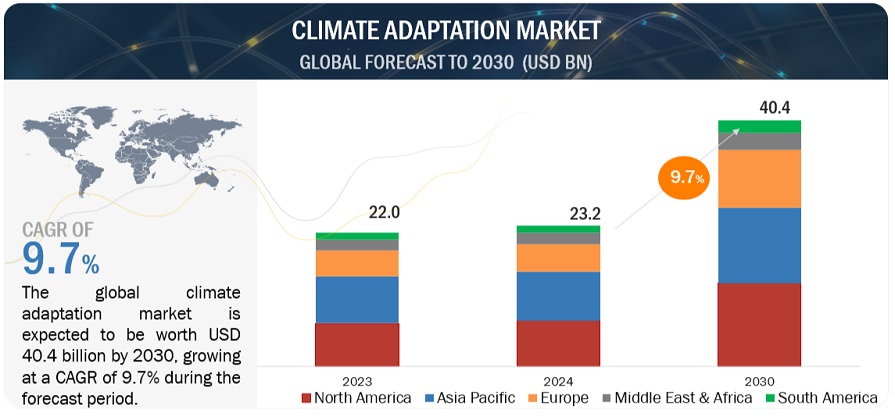The global Climate Adaptation Market in terms of revenue was estimated to be worth $23.2 billion in 2024 and is poised to reach $40.4 billion by 2030, growing at a CAGR of 9.7% from 2024 to 2030 according to a new report by MarketsandMarkets™.

The climate adaptation market is experiencing robust growth due to several new drivers. Firstly, advancements in climate modeling and data analytics are enabling more precise predictions of climate impacts, encouraging investment in adaptation technologies. Secondly, the increasing integration of Internet of Things (IoT) and artificial intelligence (AI) in climate monitoring systems enhances real-time data collection and response capabilities. Thirdly, corporate social responsibility (CSR) initiatives are pushing companies to adopt sustainable practices, including climate adaptation strategies, to improve their public image and meet stakeholder expectations. Additionally, there is a growing recognition of the economic benefits of proactive adaptation measures, such as reduced damage costs and enhanced operational efficiency, which is spurring further investment.
Download PDF Brochure: https://www.marketsandmarkets.com/pdfdownloadNew.asp?id=143809718
Government agencies hold the second-largest market share in climate adaptation market.
The Government agencies segment secures the second-largest market share within the climate adaptation market by end user segment, driven by several key factors. Government agencies are increasingly leveraging early climate warning systems and environment monitoring technologies to enhance their ability to predict and respond to climate-related risks. By deploying advanced meteorological tools and real-time data analytics, these agencies can anticipate extreme weather events such as hurricanes, droughts, and floods more accurately. This predictive capability allows governments to implement proactive measures to protect communities, infrastructure, and natural resources, thereby reducing potential damage and improving resilience. Furthermore, the integration of these systems supports evidence-based policymaking and strategic planning in adapting to changing climate conditions.
Direct Air Capture and Carbon Storage (DACCS) technology solutions to be the third-largest segment in the climate adaptation market.
Direct air capture (DAC) technology is emerging as a pivotal driver in the climate adaptation market, offering a promising solution to reduce atmospheric CO2 levels. By directly removing carbon dioxide from the air using specialized chemical processes, DAC addresses the challenge of mitigating emissions from difficult-to-decarbonize sectors like aviation and agriculture. This technology not only complements traditional carbon capture methods but also enables carbon removal from dispersed sources, enhancing flexibility in climate mitigation strategies. Moreover, DAC presents opportunities for carbon-neutral or even carbon-negative solutions, making it an attractive option for industries and governments striving to achieve ambitious climate targets and enhance environmental sustainability on a global scale.
Request Sample Pages: https://www.marketsandmarkets.com/requestsampleNew.asp?id=143809718
Europe to emerge as the third-largest climate adaptation market.
The Europe region holds the third-largest market share in the global climate adaptation market due to a confluence of factors driving significant growth potential. Based on country, the market has been segmented into Norway, the UK, France, Italy, the Netherlands, and the Rest of Europe. The Rest of Europe includes Belgium, Sweden, Ireland, Spain, and Poland. Norway has actively reduced carbon emissions since 1990, with upcoming CCUS projects in the Netherlands and the UK set to advance the region’s efforts. The EU leads in climate action by employing CCUS and negative emission technologies to meet ambitious decarbonization goals. Key initiatives include the CCS Directive, Innovation Fund, and EU Emissions Trading System (EU ETS), which support legislative frameworks, promote technological advancements and incentivize carbon capture. It also excels in environmental monitoring and early climate warning systems, using advanced satellite technology and climate models to provide early warnings for extreme weather events.
Key Players
Key players in the global Climate Adaptation Market include Baker Hughes Company (US), Exxon Mobil Corporation (US), Climeworks (Switzerland), INTERNATIONAL BUSINESS MACHINES CORPORATION (US), and Vaisala (Finland).
